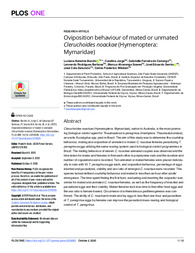Oviposition behaviour of mated or unmated Cleruchoides noackae (Hymenoptera: Mymaridae).
Oviposition behaviour of mated or unmated Cleruchoides noackae (Hymenoptera: Mymaridae).
Author(s): BECCHI, L. K.; JORGE, C.; CAMARGO, G. F. de; BARBOSA, L. R.; SOARES, M. A.; SERRÃO, J. E.; ZANUNCIO, J. C.; WILCKEN, C. F.
Summary: Cleruchoides noackae (Hymenoptera: Mymaridae), native to Australia, is the most promising biological control agent for Thaumastocoris peregrinus (Hemiptera: Thaumastocoridae), an exotic Eucalyptus spp. pest in Brazil. The aim of this study was to determine the courtship behaviour, mating and oviposition of unmated or mated C. noackae females parasitizing T. peregrinus eggs utilizing the same rearing system used in biological control programmes in Brazil. The mating behaviour of eleven C. noackae unmated couples was observed and the time taken for males and females to find each other in polystyrene vials and the duration and number of copulations were recorded. Ten unmated or mated females were placed individually in vials with 10 T. peregrinus eggs each, and oviposition behaviour, percentage of eggs inserted and parasitized, viability and sex ratio of emerged C. noackae were recorded. This species lacked defined courtship behaviour and mated in less than an hour after adults? emergence. The time spent finding the first host, evaluating and inserting the ovipositor was similar for mated and unmated C. noackae females, as well as the frequency of inserted and parasitized eggs and their viability. Mated females took less time to find other host eggs and the sex ratio is female-biased. Occurrence of arrhenotokous parthenogenesis was confirmed. The ability of C. noackae to mate and lay eggs in less than one hour and parasitism of T. peregrinus eggs by females can improve the parasitoid mass rearing and biological control of T. peregrinus.
Publication year: 2020
Types of publication: Journal article
Unit: Embrapa Forestry
Observation
Some of Embrapa's publications are published as ePub files. To read them, use or download one of the following free software options to your computer or mobile device. Android: Google Play Books; IOS: iBooks; Windows and Linux: Calibre.
Access other publications
Access the Agricultural Research Database (BDPA) to consult Embrapa's full library collection and records.
Visit Embrapa Bookstore to purchase books and other publications sold by Embrapa.

